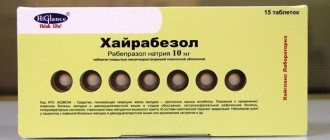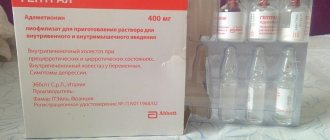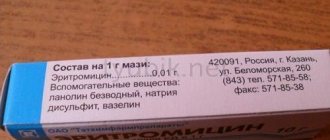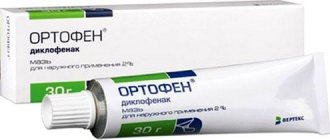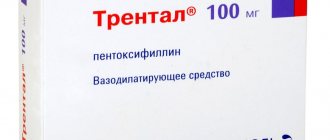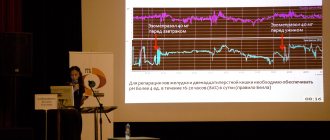Analogs
Analogues of a drug such as Controloc are Zipantol, Pantoprazole, Panum, Ulteza, Peptazol, Nolpaza, Crosacid, Sanpraz, etc. Among these analogues you can find a cheaper drug.
However, only a doctor has the right to select an analogue, just like the medicine itself. When prescribing, not only indications and contraindications must be taken into account, but also side effects that this medicine can cause.
Video on the topic: Gastritis: causes, symptoms and treatment.
Pharmacological properties of the drug Controloc tablets
Pantoprazole, the active ingredient in Controloc, inhibits the secretion of hydrochloric acid in the stomach by specifically affecting the proton pump of parietal cells. Pantoprazole is converted into its active form in an acidic environment, namely in the parietal cells of the stomach, where it inhibits H+/K+-ATPase, that is, the final phase of the formation of hydrochloric acid, regardless of the nature of the stimulus that stimulates its formation. The inhibition is dose-dependent and affects basal and stimulated gastric acid secretion. Treatment with pantoprazole reduces gastric acidity, which proportionally leads to a reversible increase in gastrin secretion. With short-term treatment, in most cases gastrin levels do not exceed the upper limit of normal. With long-term treatment, the latter in most cases doubles; excessive increases have rarely been noted. In isolated cases, with long-term treatment, a slight or moderate increase in the number of various endocrine cells of the stomach (adenomatoid hyperplasia) was determined. Pantoprazole is rapidly absorbed, its maximum concentration in the blood plasma is achieved even after taking one dose of the drug. On average, maximum concentrations of 1.0–1.5 mcg/ml are achieved 2.0–2.5 hours after dosing, and these levels remain constant after repeated dosing. The volume of distribution is 0.15 l/kg, its clearance is approximately 0.1 l/h/kg. The half-life is 1 hour. Due to the specific activation of pantoprazole in parietal cells, the half-life does not correlate with the duration of action (inhibition of acid secretion). Pharmacokinetics does not change after single or multiple doses. In the dose range from 10 to 80 mg, the pharmacokinetics of pantoprazole remain linear after both oral administration and intravenous administration. Plasma protein binding is 98%. The drug is metabolized in the liver. The main route of excretion of metabolites is renal (almost 80%), 20% is excreted in feces. The main metabolite in both plasma and urine is dismethylpantoprazole bound to sulfate. The half-life of the main metabolite (1.5 hours) is slightly longer than that of pantoprazole. Pantoprazole is completely absorbed after oral administration. The absolute bioavailability of the drug in the form of tablets resistant to gastric juice is 77%. Eating food does not affect the AUC, maximum concentration of the drug and its bioavailability. Characteristics for selected patient groups. In patients with impaired renal function (including patients on hemodialysis), there is no need to reduce the dose of pantoprazole. As in healthy subjects, the half-life of the drug in such patients is short. A small amount of pantoprazole is dialyzed. Although the half-life of the main metabolite is slightly increased (2–3 hours), it is rapidly eliminated and thus does not accumulate. Although in patients with liver cirrhosis (class A and B), the half-life of pantoprazole increases to 3-6 hours and the AUC increases accordingly by 3-5 times, the maximum concentration of pantoprazole in blood plasma increases by 1.3 times compared with that in healthy subjects . The slight increase in AUC and increase in maximum concentration in elderly patients compared with the corresponding data in younger patients are not clinically significant.
Indications for use
Control is recommended for use if you have:
- nonerosive reflux disease (NERD);
- gastroesophageal reflux disease (GERD);
- erosive reflux esophagitis;
- ulcers of the duodenum, as well as stomach , including in the acute phase;
- eradication of Helicobacter pylori;
- erosive gastritis , including those caused by taking NSAIDs;
- Zollinger-Ellison syndrome.
The drug in powder form is usually used for the treatment and prevention of:
- complications caused by an ulcer , for example, perforation or bleeding ;
- stress ulcers.
Controloca price, where to buy
The cost of the drug varies depending on the release form and nominal volume. Price of Controloc 20 mg. (14 tablets per package) on average does not exceed 700 rubles. Price Controloc 40 mg. (14 tablets per package) fluctuates at the level of 800-900 rubles. One bottle of powder for preparing a solution for intravenous injection costs about 350 rubles.
- Online pharmacies in RussiaRussia
- Online pharmacies in UkraineUkraine
- Online pharmacies in KazakhstanKazakhstan
ZdravCity
- Controloc tablets p.p.o.
40 mg 14 pcs. Takeda GmbH RUB 399 order - Controloc powder for injection solution for intravenous injection. 40mg Takeda GmbH
RUB 355 order
- Controloc tablets p.p.o. 40 mg 28 pcs. Takeda GmbH
RUR 537 order
- Controloc tablets p.p.o. 20 mg 14 pcs. Takeda GmbH
RUB 266 order
Pharmacy Dialogue
- Controloc (tab.p/vol.40mg No. 28)Takeda
RUR 589 order
- Controloc (tab.p/vol.40mg No. 14)Takeda
430 rub. order
- Controloc (tab.p/vol.20mg No. 14)Takeda
RUB 303 order
- Controloc (portable for prepared solution IV bottle 40 mg)Nycomed
RUR 366 order
- Controloc (tab.p/vol.20mg No.14)Nycomed
RUB 299 order
show more
Pharmacy24
- Controloc 20 mg No. 14 tablets Takeda GmbH, city of Vir-va Oranienburg, Germany
234 UAH.order - Controloc 40 mg N1 powder Takeda GmbH, Nimecchina/Patheon Italy S.p.A. , Italy/Wasserburger Arznaimittelwerk GmbH , Nimecchin
135 UAH order
- Controloc 40 mg No. 14 tablets Takeda GmbH, University of Oranienburg, Germany
311 UAH. order
PaniPharmacy
- Controloc bottle Controloc pores. d/in. 40 mg No. 1 Germany, Takeda
158 UAH order
- Controloc tablets Controloc tablet 20 mg No. 14 Germany, Takeda
254 UAH order
- Controloc tablets Controloc tablets. 40 mg No. 14 Germany, Takeda
328 UAH. order
show more
special instructions
Before starting therapy, it is necessary to exclude the possibility of malignant neoplasms, since Controloc can mask their signs and delay diagnosis.
Before performing a urea breath test or endoscopy, you should consult with your prescriber. You should also consult a doctor if you have the following diseases/conditions:
- Anemia, unintentional weight loss, gastrointestinal bleeding, swallowing disorders, vomiting blood or persistent vomiting (the use of Controloc may partially alleviate the symptoms of the disease and delay correct diagnosis);
- Gastric ulcer or previous surgery on the gastrointestinal tract;
- Continuous long-term (from 4 weeks) symptomatic treatment of heartburn and dyspepsia;
- Liver diseases, including jaundice and liver failure;
- Other serious illnesses that worsen general health.
Patients over 55 years of age should consult a doctor if new or recently changed symptoms appear.
When used simultaneously with drugs that reduce the acidity of gastric juice, the risk of developing infections caused by bacteria of the gastrointestinal genus Campylobacter spp., Salmonella spp. slightly increases. or Clostridia difficile.
During therapy, it is recommended to refrain from driving vehicles and other mechanisms that require quick reactions and increased attention (due to the likelihood of developing visual impairment and dizziness).
Directions for use and dosage
Controloc in tablet form is taken orally before meals with a sufficient amount of liquid. Tablets should not be chewed or crushed.
The dosage regimen is determined by the indications.
When treating mild symptoms of gastroesophageal reflux disease (such as nausea, heartburn, sour belching), adults are prescribed 20 mg of Controloc orally. As a rule, positive dynamics are achieved within 2-3 days of taking the drug, however, to completely eliminate symptoms, therapy is usually continued for 7 days. If the condition worsens in the first 3 days of treatment, as well as in cases where there is no improvement when taking Controloc continuously for 14 days, you should consult your doctor.
For gastric and duodenal ulcers and erosive gastritis (including those associated with the use of non-steroidal anti-inflammatory drugs), Controloc is prescribed in a daily dose of 40-80 mg. In case of exacerbation of duodenal ulcer, the course of therapy is 14 days, of the stomach - 4-8 weeks. To prevent the development of relapse of gastric and duodenal ulcers, the drug is taken at a dose of 20 mg per day.
For the eradication of Helicobacter pylori, Controloc in a single dose of 20-40 mg is recommended to be used simultaneously with the following drugs (single dose):
- Amoxicillin – 1000 mg, clarithromycin – 500 mg;
- Metronidazole – 500 mg, clarithromycin – 500 mg;
- Amoxicillin – 1000 mg, metronidazole – 500 mg.
The frequency of use of all drugs is 2 times a day. The duration of the therapeutic course is 1-2 weeks.
For Zollinger-Ellison syndrome, Controloc is prescribed in a daily dose of 40-80 mg.
In patients with severe functional liver disorders, the dose is reduced to 40 mg once every 2 days, and biochemical blood parameters must be monitored. If the level of liver enzymes increases, the use of Controloc should be interrupted.
Elderly patients, as well as patients with functional renal impairment, do not require dose adjustment, but the daily dose should not exceed 40 mg (except for combination antibacterial therapy against Helicobacter pylori, when the drug is taken at 40-80 mg in 2 doses).
Controloc should not be taken for preventive purposes.
Controloc solution is administered intravenously in cases where oral administration of the drug is impossible. The recommended daily dose is 40 mg.
For long-term treatment of Zollinger-Ellison syndrome and other pathological conditions with increased secretory function, the drug is administered at the beginning of treatment at 80 mg per day. Depending on the response to Controloc, the daily dose may be reduced or increased. If the daily dose exceeds 80 mg, the drug should be administered in 2 doses. If necessary, a temporary dose increase to 160 mg per day is possible.
The same dosing regimen is used for the prevention and treatment of stress ulcers and their complications (perforation, bleeding, penetration).
To prepare the Controloc solution, 10 ml of physiological sodium chloride solution should be added to the bottle containing the dry substance. The solution can be used after mixing with 100 ml of physiological sodium chloride solution, as well as with 5% glucose solution.
Controloc solution for intravenous administration should have a pH of 9. The drug is administered over 2-15 minutes.
The prepared solution can be stored for no more than 3 hours.
Release form and composition
Controloc is available in the following dosage forms:
- Enteric-coated tablets: biconvex, oval, yellow film-coated, with an almost white to white core; on one side – marking in brown ink (20/40 mg tablets) “P20” or “P40” (5 pcs in blisters, 3 blisters in a cardboard pack; 7 pcs in blisters, 1, 4 blisters in a cardboard pack; 14 pcs. in blisters, 1, 2 blisters in a cardboard pack);
- Powder for preparing a solution for intravenous administration: almost white or white dry substance (in bottles, 1 bottle in a cardboard box).
1 tablet contains:
- Active substance: pantoprazole – 20 or 40 mg (in the form of pantoprazole sodium sesquihydrate – 22.57 or 45.1 mg);
- Auxiliary components: anhydrous sodium carbonate – 5/10 mg, crospovidone – 25/50 mg, mannitol – 21.33/42.7 mg, povidone K90 – 2/4 mg, calcium stearate – 1.6/3.2 mg, purified water – 4.5/9 mg.
Coating composition (20/40 mg tablets, respectively): hypromellose 2910 – 11.88/19 mg, povidone K25 – 0.24/0.38 mg, titanium dioxide (E171) – 0.21/0.34 mg, dye iron oxide yellow (E172) – 0.02/0.03 mg, propylene glycol – 2.66/4.25 mg, eudragit L30D-55 – 8.18/14.56 mg (ethyl acrylate and methacrylic acid copolymer [1:1 ] – 7.94/14.13 mg, polysorbate 80 – 0.18/0.33 mg, sodium lauryl sulfate – 0.06/0.1 mg), triethyl citrate – 0.82/1.45 mg.
Composition of brown Opacode S-1-16530 ink for marking tablets: shellac (shellac) – 0.036 mg, concentrated ammonia solution 25% – 0.001 mg, dyes (iron oxide red (E172) – 0.009 mg, iron oxide black (E172 ) – 0.009 mg, iron oxide yellow (E172) – 0.0009 mg).
The composition of 1 bottle for the preparation of solution for injection includes:
- Active substance: pantoprazole – 40 mg (in the form of pantoprazole sodium sesquihydrate – 45.1 mg);
- Auxiliary components: disodium edetate – 1 mg, sodium hydroxide – 0.24 mg.
Drug interactions
Controloc may reduce the absorption of drugs whose bioavailability depends on the pH of the stomach (including ketoconazole, iron salts).
Without the risk of drug interactions, Controloc can be used simultaneously with drugs such as:
- Beta-blockers (metoprolol), slow calcium channel blockers (nifedipine), cardiac glycosides (digoxin): for diseases of the cardiovascular system;
- Antacids, antibiotics (clarithromycin, amoxicillin): for diseases of the gastrointestinal tract;
- Diazepam: for anxiety and sleep disorders;
- Levothyroxine, glibenclamide: for diseases of the endocrine system;
- Tacrolimus, cyclosporine: after transplantation;
- Oral contraceptives containing levonorgestrel and ethinyl estradiol;
- Non-steroidal anti-inflammatory drugs (piroxicam, diclofenac, naproxen, phenazone);
- Phenytoin, carbamazepine;
- Indirect anticoagulants (phenprocoumon, warfarin).
The development of clinically significant drug interactions with ethanol, caffeine and theophylline was not noted.
